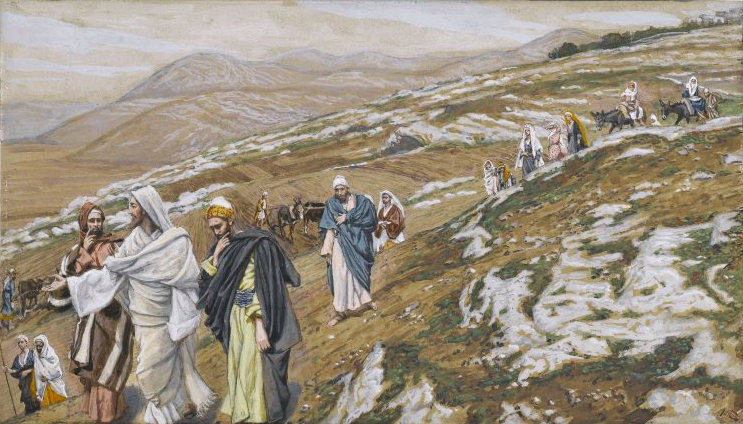Translation of the Holy Gospel According to Matthew
At that time, when Jesus was come down from the mountain, great multitudes followed Him: and behold a leper came and adored Him saying: Lord, if Thou wilt, Thou canst make me clean. And Jesus, stretching forth His hand touched him, saying: I will. Be thou made clean. And forthwith his leprosy was cleansed. And Jesus saith to him: See, thou tell no man: but go, show thyself to the priest, and offer the gift which Moses commanded, for a testimony unto them. And when He had entered into Capharnaum, there came to Him a centurion, beseeching Him, and saying: Lord, my servant lieth at home sick of the palsy, and is grievously tormented. And Jesus saith to him: I will come and heal him. And the centurion making answer said: Lord, I am not worthy that Thou should enter under my roof: but only say the word and my servant shall be healed. For I also am a man subject to authority, having under me soldiers; and I say to this: Go, and he goes; and to another: Come, and he comes; and to my servant: Do this, and he does it. And Jesus hearing this marveled, and said to them that followed Him: Amen I say to you, I have not found so great faith in Israël. And I say to you, that many shall come from the east and the west, and shall sit down with Abraham and Isaac and Jacob in the kingdom of heaven: but the children of the kingdom shall be cast out into the exterior darkness: there shall be weeping and gnashing of teeth. And Jesus said to the centurion: Go, and as thou hast believed, so be it done to thee. And the servant was healed at the same hour.
From St. John Paul II’s General Audience, September 6th, 2000.
The encounter with Christ radically changes a person’s life, spurs him to metanoia or a profound conversion of mind and heart, and establishes a communion of life which becomes discipleship. In the Gospels, the following of Christ is expressed in two attitudes: the first consists in “going with” Christ (akolouthein); the second, in “walking behind” the One who leads, following in his footsteps and direction (erchesthai opiso). This gives rise to the figure of the disciple, which is realized in different ways. Some follow him in a still general and often superficial way, like the crowd (cf. Mark 3:7, 5:24; Matt 8:1). There are sinners (cf. Mark 2:14-15); the women who support Jesus’ mission with their practical service are mentioned several times (cf. Luke 8:2-3; Mark 15:41). Some receive a specific calling from Christ, and among them a special place is reserved for the Twelve.
The typology of those called is thus quite varied: people involved in fishing and tax collectors, the honest and sinners, the married and the single, the poor and the wealthy, such as Joseph of Arimathea (cf. John 19:38), men and women. There is even Simon the Zealot (cf. Luke 6:15), that is, a member of the anti-Roman revolutionary opposition. And there were some who refused the invitation, like the rich young man who, at Christ’s demanding words, was saddened and went away sorrowful, for he had great possessions (Mark 10:22).
The conditions for taking the same way as Jesus are few but fundamental. As we heard in the Gospel passage read a few moments ago; it is necessary to turn one’s back on the past and make a clean break with it, a metanoia in the profound sense of the word: a change of mind and life.
Christ proposes a narrow way that demands sacrifice and total self-giving: If any man would come after me, let him deny himself and take up his cross and follow me (Mark 8:34). It is a way that includes the thorns of suffering and persecution: If they persecuted me, they will persecute you … also (John 15:20). It is one which makes missionaries and witnesses to Christ’s word, but demands that his apostles take nothing for their journey … no bread, no bag, no money in their belts (Mark 6:8; cf. Matt 10:9-10).
Discipleship, then, is not an easy journey on a level road. It can include moments of hardship to the point that on one occasion many of his disciples drew back and no longer went about with him (John 6:66), that is, with Jesus, who was compelled to challenge the Twelve with a crucial question: Will you also go away? (John 6:67). On another occasion, when Peter himself rebels against the prospect of the Cross, he is abruptly rebuked in words that, according to the nuance of the original text, could be an invitation to get “behind” Jesus again, after trying to reject the goal of the Cross: Get behind me, Satan! For you are not on the side of God, but of men (Mark 8:33).
The risk of betrayal will be lurking for Peter who in the end, however, would follow his Master and his Lord with the most generous love. Peter, in fact, will make his profession of love on the shores of the Sea of Tiberias: Lord, you know everything; you know that I love you. And Jesus will tell him by what death he was to glorify God, adding twice, Follow me! (John 21:17, 19, 22).
Discipleship is expressed in a special way in the beloved disciple, who enters into intimacy with Christ, receives his Mother as a gift and recognizes him after he has risen (cf. John 13:23-26, 18:15-16, 19:26-27, 20:2-8, 21:2, 7, 20-24).
The ultimate goal of discipleship is glory. The way is one of “imitating Christ”, who lived in love and died for love on the Cross. The disciple must, so to speak, enter into Christ with all his own self, he must ‘appropriate’ and assimilate the whole of the reality of the incarnation and redemption in order to find himself (Redemptor hominis, 10). Christ must enter into his ego to free him from selfishness and pride, as St. Ambrose says in this regard: May Christ enter your soul, may Jesus dwell in your thoughts, to prevent sin from having any room in the sacred tent of virtue (Comment on Psalm 118, letter “daleth”, 26).
The Cross, sign of love and of total self-giving, is therefore the emblem of the disciple called to be configured to the glorious Christ. A Father of the Eastern Church, who was also an inspired poet, Romanus the Melodist, challenges the disciple in this way: You have the Cross as your cane; rest all your youth on it. Bring it to your prayer, bring it to the common table, bring it with you to bed and everywhere, as your claim to glory…. Say to your spouse who is now joined to you: I throw myself at your feet. In your infinite mercy, give peace to your world, help to your Churches, concern to pastors and harmony to the flock, so that we may all sing of our resurrection forever (Hymn 52: “To the newly baptized”, strophes 19 and 22).



